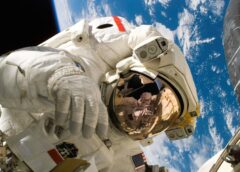Lee esta nota de prensa en español aquí.
The President’s fiscal year 2023 budget would allow NASA to sustain America’s global innovation leadership and keep NASA at the forefront of exploration and discovery by returning to the Moon with the Artemis program, among other efforts. This budget would enable NASA to address climate change, drive economic growth, and promote diversity, equity, inclusion, and accessibility.
The Biden-Harris Administration Monday submitted to Congress President Biden’s budget for fiscal year 2023. The President’s budget details his vision to expand on the historic progress our country has made over the last year and deliver the agenda he laid out in his State of the Union address – to build a better America, reduce the deficit, reduce costs for families, and grow the economy from the bottom up and middle out.
“Greater than a number, statistic, or fact is what the President’s budget request represents,” NASA Administrator Bill Nelson said. “This budget reflects the Biden-Harris Administration’s confidence in the extraordinary workforce that makes NASA the best place to work in the federal government. It’s an investment in the businesses and universities that partner with NASA in all 50 states and the good-paying jobs they are creating. It’s a signal of support for our missions in a new era of exploration and discovery.”
The budget makes critical investments in the American people that will help lay a strong foundation for shared growth and prosperity for generations to come.
At NASA, the budget would:
- Enable missions on and around the Moon through Artemis while preparing for Mars exploration. The budget provides $7.6 billion for deep space exploration. Through Artemis missions, NASA will land the first woman and person of color on the lunar surface, deepen the United States’ scientific understanding of the Moon, and test technologies that will prepare for human exploration of Mars.
- Allow NASA to support and enhance lunar missions. The budget’s $4.7 billion for Common Exploration Systems Development to support lunar missions includes funding for the Orion spacecraft and Space Launch System (SLS). The budget’s $1.5 billion for astronaut Moon landers will enable NASA to increase competition in the development of the final mode of transportation needed to take astronauts to the lunar surface.
- Increase NASA’s Earth science funding for climate and weather monitoring and measurement. The budget’s $2.4 billion for Earth-observing satellites and related research will enhance NASA’s ability to improve the world’s understanding of climate change.
- Help NASA support commercial space activities. The budget’s $1.4 billion for space technology research and development will support new technologies to help the U.S. commercial space industry grow, enhance mission capabilities, create good-paying jobs, and reduce costs.
- Maintain U.S. leadership in aircraft development and improve aviation to deliver benefits to the public. The budget would provide $970 million for aeronautics research. This includes $500 million to reduce aviation’s climate impact through efforts including a Sustainable Flight National Partnership to develop a next-generation passenger aircraft.
- Allow NASA to continue building productive, strategic education collaborations. With $150 million for the Office of STEM Engagement for education and engagement activities, this budget would allow NASA to enhance its support for educational activities, including those that focus on historically underserved communities.
The budget makes these smart investments while also reducing deficits and improving our country’s long-term fiscal outlook.
For more information on NASA’s fiscal year 2023 discretionary request, visit:
Source: NASA


